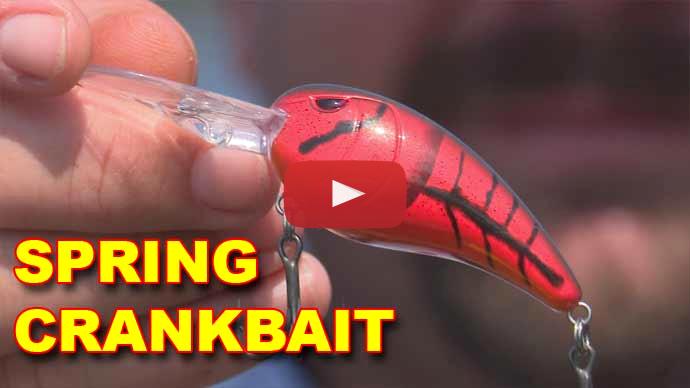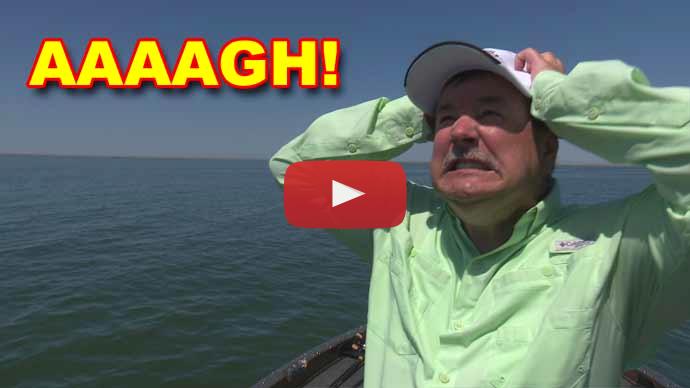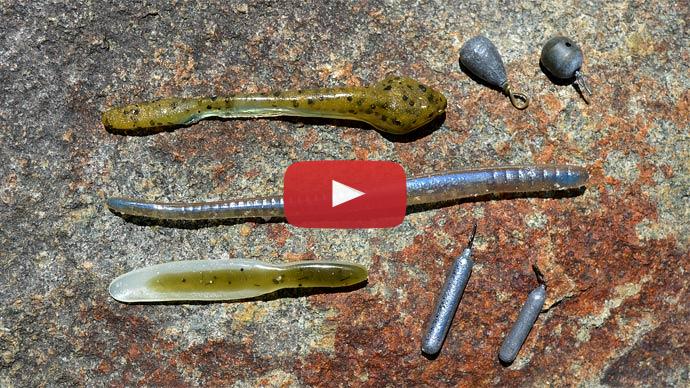Hey, guys, Cliff Pirch here for BassResource.com. Today we're talking a little bit about the drop shot and specifically fishing a drop shot in the spring. So, the drop shot technique, really it's a good year-round technique because it works well deep, works well shallow, around cover, around offshore breaks, all kinds of things and all kinds of situations, even some suspended fish. But specifically, we're gonna talk about fishing shallow. And in the spring we've got a pre-spawn period, a spawn period, a post-spawn, so obviously there is a movement of fish from offshore or deep up to shallow and then back out. We're gonna talk a little bit about shallow.
So, what I like about the drop shot is I can fish a specific target. And a lot of times in the spring, you know, a fish is gonna spawn up near a log, a clump of pads or grass, some type of cover, a dock pole, a sea wall, things like that. And what this does, I can put it in that strike zone and impart action in that same strike zone without pulling it out of the strike zone. So, that's kind of the beauty of a drop shot. If you've got a jerkbait you've gotta throw it in there, jerk it, reel it, wind it, and in order to impart action, it comes into the strike zone and leaves the strike zone, same with a crankbait, a spinnerbait, a chatterbait, anything like that.
So, the beauty of a drop shot is it targets that strike zone and gives action but it never leaves, so if they're pressured fish or if they're slow to bite, a lot of times it's a good way to get that tricky bite. They're there and they won't chase something but they will get tired of this thing being there.
So, again, lots of folks know about the drop shot, but I'll just go through the whole rig itself. Basically, what I wanna do is suspend a worm up off the bottom. I've got a little Big Bite Scentsation Cliff Hanger Worm here. And I really like a straight-tail worm. I don't really use a curly tail worm much. That's a little bit more for action and things like that. So, I really like just a real mild little finesse straight-tail worm. And I've got a little light drop shot weight. This is quarter ounce. And I've got it on a spinning reel. You can also use heavier tackle in heavier cover, you know, with a bait caster, heavier weight, heavier line, all that.
But basically, I've tied my hook on and I've left about a 12 to 14-inch tagline, and then once I've tied it on, I take that tagline, I run the tagline down through the top of the hook. And what it does is it puts that hook upright. So, when you're setting the hook, you're always setting it towards the hook point. You'll still catch some fish if it's not rigged that way or if it's upside down, but you're gonna get a lot better hook-up ratio and landing ratio if you have that hook point up. And, you know, hooking them in the top of the mouth is also a better place to hook a bass. So, that's why I do that. And it also stands that worm out just a little bit.
And the nature of this little Big Bite Bait Scentsation Cliff Hanger Worm, it's, like, a real soft, light handpour. So, it's not heavy, it's fairly buoyant, and it will set there. I can let off and slack off and it will sink a little bit because of the weight of the hook, but in general, I want it to be really, really natural and suspending and move as the current or as the water moves a little bit. So, it looks real natural.
That's why I typically wanna lean towards a little lighter line. They're gonna get a long look at it. They're gonna see it really good. So, the lightest line I can get away with for the cover and the size of fish I'm dealing with, the lighter the better. I've drop-shotted them on heavy line, like 15 or even 20, but if you've got somewhat clear water and you can handle it with a cover, I'm gonna lean towards a spinning setup more often with lighter line. And a spinning rod and a spinning reel setup handles light line better. It's got a superior drag system to a bait caster. So, that's why I would lean towards this. And most of the time, I am using light line.
And again, I've taken this tagline now, it's about 12 to 14 inches, and I've got a 1/4-ounce weight here. You can vary your weight, but I keep it pretty simple on light line. I'm right around 1/4 a lot of times unless I've got heavier current or, you know, I'm fishing deep or a lot of wind or something like that, but most of the time, I'm just with, like, a little 1/4 ounce and 12, 14 inches, and that basically is gonna put it right in that strike zone.
So, I'm gonna pick a target, especially in the spring since we're talking specifically about spring fishing. I'm gonna pick a target. I've got a little dock pole over there. I'm gonna let it fall basically by it. And it's shallow there. So, I'm already on the bottom. I've got the line in my finger so I can feel that, have that sensitivity there. And I'm gonna let it go to the bottom, and I'm just gonna kill it there. I want that drop-shot weight to act like an anchor and it suspends that bait there. So, then I'm gonna have it on the semi-slack line. You don't want a whole bunch of slack because you can't feel or tell what's going on there, and you don't want it real tight because when they bite it, you want them to take it in. So, it's just a semi-bow in my line, a semi-slack line. I give it just a little bit of action and I might shake it a little bit. I might kill it and let it slowly fall. Again, you've got the weight of that hook on there to let it fall a little bit. And it's a very buoyant worm. It's like a little soft handpour, really, really soft.
And as far as my hook goes, I want a nice light wire worm hook. So, I don't wanna overpower the worm with a heavy hook. For one, I've got a soft rod. This is a Phenix K2. I like a little longer one. Some guys are in the 6'9" range. This is a 7'6". And so it's like a medium action or a pretty soft tip because I'm using light line and I want them to be able to take it in, but also because that hook I'm talking about, it's a light wire hook and I don't wanna bend that open. You know what I mean? So, the hook needs to not overpower the worm or the line and the rod. So, it's all a pretty good match and that's why I want a light wire hook. Again, I'm not gonna have a ton of hook-setting power with a soft rod like that.
And when I do set the hook, I'm going to... I'll toss back over there. When I set the hook or I know there's one swimming off with it, a lot of times you may feel a tick, but it might just get heavy. You might feel pressure, feel your line swimming off. And what I'm gonna do is I'm gonna start to reel to get tension on it, and then I'm gonna bow up and just keep pressure. And again, you know, you want your drag soft, be able to handle the fish on that light line, and that's why that spinning reel really comes in handy.
So, that's my drop-shot technique. Again, it's a great year-round technique. In the spring, I'm targeting shallow targets. And a lot of times those are visible targets. So, I'm looking at...especially right here, I've got some shallow dock poles, some docks. I know those bass are gonna be spawning in one to four or five feet, depending on the clarity.
Out West, you might have gin-clear water and they might spawn in 10 feet, but it's still a good technique for that. So, I'm gonna pick a tree, a brush pile, lily pad stems, dock pole, any type of visible target I can see.
And again, on your electronics, with the electronics of forward-looking technology now, a lot of times I'm seeing targets out there that aren't visible above the water. So, it works the same for that. And it's actually especially good with that forward-looking technology. Now, I've got the ActiveTarget from Lowrance on here that I use. And you're able to actually see those targets out there. I can fish that target and know that my bait has fallen right where it needs to be. And again, it's not something I use to cover water. I don't really drag it around up in there much. I find a target, throw it in there, kill it, you know, fish it for a few seconds. It might be five seconds. It might be 10 to 20 seconds. I've seen where if you feel good about one being there or you may know one is there, it may take a long time, but you know that your bait is still in that strike zone. And eventually, most of the time, they're just gonna grab it and swim it off out of there.
So, it's a great technique, really good for getting bites, a lot of bites. It's good for getting pressured fish. If you get a lot of fishing pressure, it's a little more natural, it's more subtle, gets a lot of bites.
Can it catch big ones? Yes. It's a great way to catch big ones. A lot of times if I'm in an area that has a lot of big fish, well, the big goal then is just to get bites. I know I'm gonna get some of those big ones. If I have a specific spot that I know holds big fish, again, it's a good technique. But, in general, it's a really good bite-getter. So, lots of action and can catch big ones.
I've caught up to 9, 10 pounders on this and just a little 4.5-inch worm and putting it in that strike zone. If you've got a big female spawning up there or holding it tight on cover, they'll bite it. So, again, it's mainly a clear water technique, so they're gonna get a really good look at it, but, you know, those are some things that I like about drop shotting. And again, works great year-round, but those spring targets are gonna be really good places to pitch that drop-shot worm.



